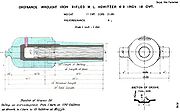
RML 6.3 inch Howitzer
Encyclopedia
The RML 6.3 inch howitzer was a British rifled muzzle-loading "siege" or "position" howitzer/mortar proposed in 1874 and finally introduced in 1878 as a lighter version of the successful 8 inch howitzer that could be carried by the existing 40-pounder gun carriage.
By 1880 the RML 6.3 inch was superseded by a longer 6.6 inch howitzer with higher muzzle velocity.
 The barrel consisted of an inner "A" tube of toughened mild steel, surrounded by wrought-iron "B" tube and jacket.
The barrel consisted of an inner "A" tube of toughened mild steel, surrounded by wrought-iron "B" tube and jacket.
Rifling was of the "polygroove" type, with 20 grooves and a twist increasing from 1 turn in 100 calibres (i.e. 630 inches) to 1 in 35 (i.e. 220 inches).
 The gun was the first British rifled muzzle-loader to dispense entirely with studs on shells to impart spin : its shells from the beginning had gas checks attached to their base which expanded and engaged with rifling on firing to impart spin to the shell.
The gun was the first British rifled muzzle-loader to dispense entirely with studs on shells to impart spin : its shells from the beginning had gas checks attached to their base which expanded and engaged with rifling on firing to impart spin to the shell.
By 1880 the RML 6.3 inch was superseded by a longer 6.6 inch howitzer with higher muzzle velocity.
Description

Rifling was of the "polygroove" type, with 20 grooves and a twist increasing from 1 turn in 100 calibres (i.e. 630 inches) to 1 in 35 (i.e. 220 inches).
Second Boer War
A number of RML 6.3 inch howitzers were used by the British forces during the Second Boer War, normally mounted on 40 pr RML carriages.Ammunition

Surviving examples
- Two of these guns, called Castor and Pollux, used during the Siege of LadysmithSiege of LadysmithThe Siege of Ladysmith was a protracted engagement in the Second Boer War, taking place between 30 October 1899 and 28 February 1900 at Ladysmith, Natal.-Background:...
stand in front of the LadysmithLadysmith, KwaZulu-NatalLadysmith is a city in the Uthukela District of KwaZulu-Natal, South Africa. It is north-west of Durban and south of Johannesburg. Important industries in the area include food processing, textile and tyre production...
town hall. They have been declared Heritage Objects by the South African Heritage Resource Agency.. Both the guns and their ammunition were outdated by the time of the siege and they tended to make a lot of smoke when fired.

